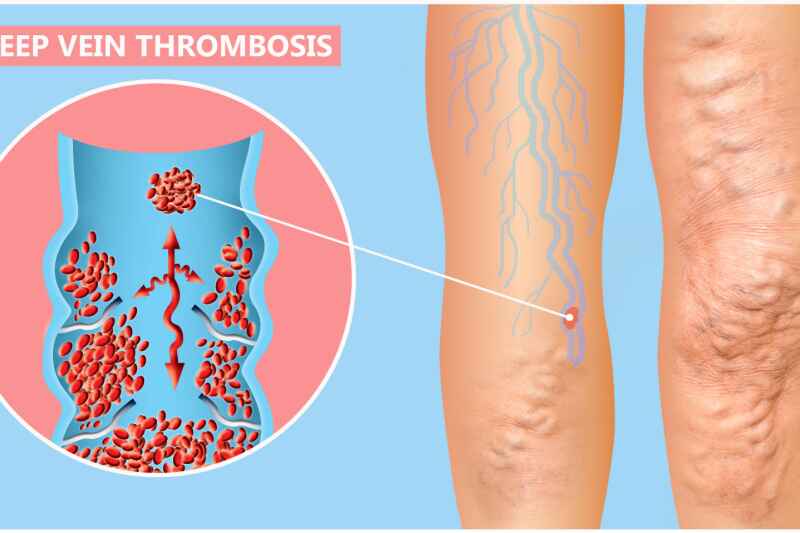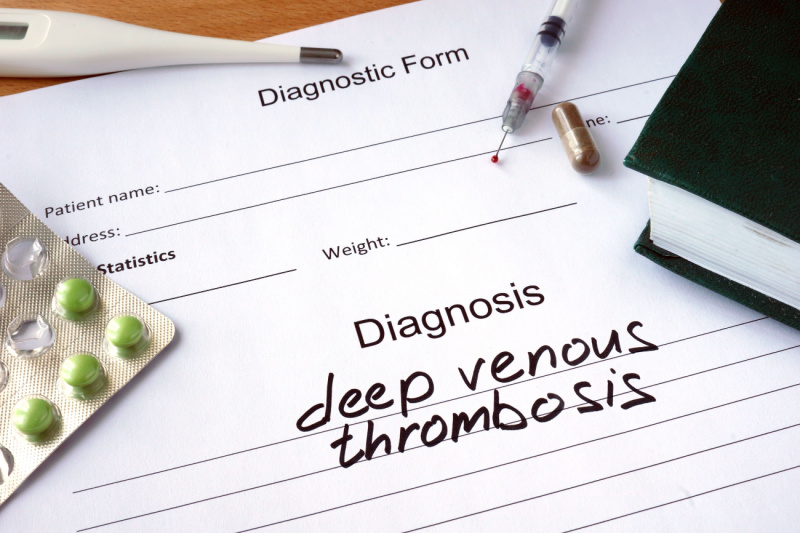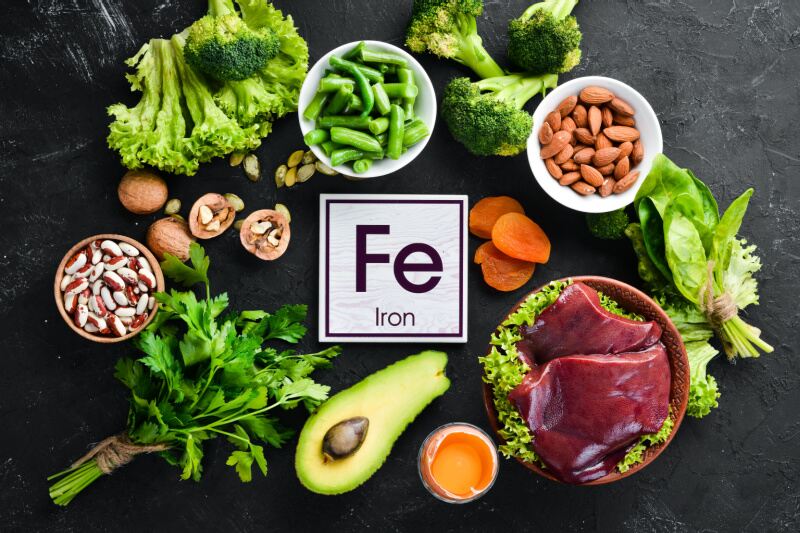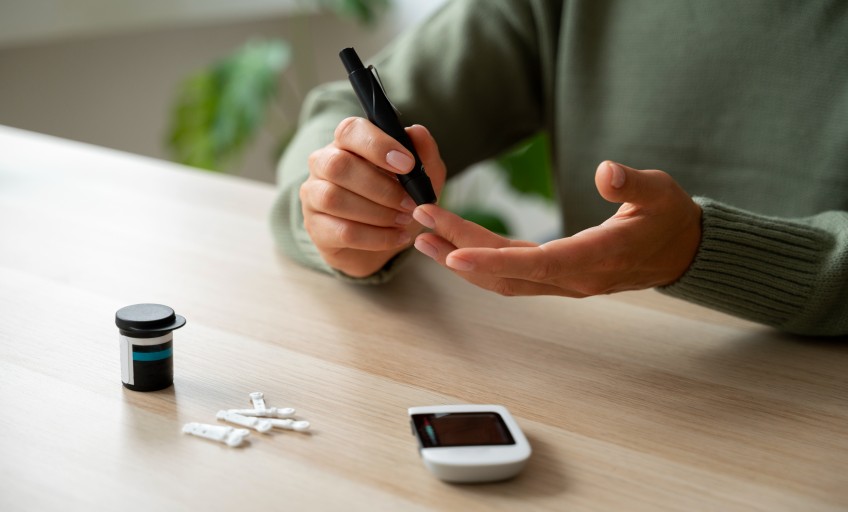Deep vein thrombosis (DVT) is a type of blood clot typically sitting deep within our body, usually in the legs. As this is a serious health condition, you should get yourself checked immediately. Treatment options for DVT include medicines, compression stockings, and even surgery.
इनके बारे में जानें:
- Understanding deep vein thrombosis (DVT)
- Symptoms and signs of deep vein thrombosis (DVT)
- Causes of deep vein thrombosis (DVT)
- Preventive measures
Understanding deep vein thrombosis (DVT)

Deep vein thrombosis (DVT), or venous thrombosis, happens when a blood clot, known as a thrombus, develops in deep veins due to slow blood flow or vein damage. These clots can partially or fully obstruct the vein’s blood flow. While DVT commonly affects the lower leg, thigh, or pelvis, it can also develop in other body areas, including the arm, brain, intestines, liver, or kidney. These clots can also travel to the blood vessels near your lungs and block them, causing a pulmonary embolism. This is a severe condition that requires immediate medical attention. Almost 50% of people with DVT in their legs experience symptoms like recurring leg pain and swelling, lasting from months to years.
Key features of this syndrome include:
- Blood pooling
- Persistent leg swelling
- High vein pressure
- Leg ulcers
Symptoms and signs of deep vein thrombosis (DVT)
Here are the most common signs and symptoms of deep vein thrombosis:
- Leg and arm swelling
- Pain and tenderness in your legs and arms while sitting or standing
- Warmness in the swollen area on your leg or arms
- Red or discolored skin
- Sudden headaches and even seizures
- More prominent veins near your skin’s surface
- Flank or abdominal pain
While DVT causes significant health concerns, some people may not be aware of deep vein thrombosis until the blood clot travels to your lungs and affects it. Symptoms of such a condition include chest pain, shortness of breath, blood from coughing, and lightheadedness. If you experience any of these symptoms, visit a medical expert immediately to stave off negative health impacts on your body.
Causes of deep vein thrombosis (DVT)
Here are the most common causes of deep vein thrombosis:
- Genetic predispositions can elevate the risk of blood clots
- Cancer and specific chemotherapy treatments
- Personal or family history of deep vein thrombosis
- Reduced blood flow in a deep vein due to injury, surgery, or being sedentary
- Prolonged immobility, such as long periods of sitting during travel or after surgery or severe injury
- Pregnancy or recent childbirth
- Being over 40, though, DVT can occur at any age
- मोटापा
- Autoimmune disorders like lupus, vasculitis, or inflammatory bowel disease
- Use of contraceptive pills or hormone therapy
- Having a central venous catheter or pacemaker installed
Preventive measures

Here are some common deep vein thrombosis treatments and preventive measures that you can incorporate into your daily routine:
Maintaining physical activities
Lead a physically active lifestyle. Ensure you get 30 minutes of exercise to charge up your body and manage weight. Go for a run, jog, take the stairs, and get 10,000 steps in daily. The key is to work on your calf muscles to avoid this condition further.
Avoiding prolonged sitting
Move around as much as you can. The more you move your body and legs, the less you can get affected by deep vein thrombosis. Also, don’t cross your legs and sit; it can block blood flow.
Hydration and lifestyle adjustments
Stay hydrated, especially when travelling from one place to another. This can decrease swelling and aid in proper circulation in your body.
The best preventive measure for deep vein thrombosis is moving around as much as possible. If you feel uncomfortable or if your DVT symptoms worsen, visit a hospital to get it treated immediately.
Stay tuned to the Activ Living Community. Keep up to date with the latest health tips and trends through expert videos, podcasts, articles, and much more in पोषण, फिटनेस, सचेतन, और लाइफस्टाइल से जुड़ी बीमारियां like Asthma, Blood Pressure, Cholesterol, and Diabetes. Activ Living ke saath sahi sehat ki shuruaat ABHIkaro.
You may also be interested in the following blogs:
- What is CrossFit Exercise? 3 Health Benefits To Level Up Your Fitness Game
- Boost Your Wellness With These 4 Diabetes Management Lifestyle Changes
Popular Searches
How to lower blood pressure | Fruits good for liver | Unhealthy foods | रागी के लाभ | बेसल मेटाबोलिक रेट | हाई ब्लड प्रेशर के लिए एक्यूप्रेशर पॉइंट्स | Ayurvedic medicine for blood pressure | How to control cholesterol at home | Homeopathy for Asthma | Biological Age | Home remedies for TB | Natural beta blockers | Negative effects of internet | Types of walking | ब्लड प्रेशर कैलकुलेटर | ब्लड शुगर कैलकुलेटर | BMI कैलकुलेटर





 1800-270-7000
1800-270-7000







